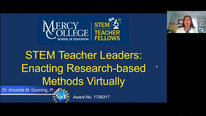- Meltem Alemdar
- https://www.ceismc.gatech.edu/about/staffdirectory/meltem-alemdar
- Senior Research Scientist/PI
- Presenter’s NSFRESOURCECENTERS
- Georgia Institute of Technology
- Christopher Cappelli
- https://www.ceismc.gatech.edu/about/staffdirectory/christopher-cappelli
- Research Associate II/Co-PI
- Presenter’s NSFRESOURCECENTERS
- Georgia Institute of Technology
- Jessica Gale
- https://www.ceismc.gatech.edu/about/staffdirectory/dr-jessica-gale
- Senior Research Scientist/Co-PI
- Presenter’s NSFRESOURCECENTERS
- Georgia Institute of Technology
- Shaheen Rana
- Research Associate II/Senior Researcher
- Presenter’s NSFRESOURCECENTERS
- Georgia Institute of Technology
- Steven Taylor
- Communications Manager
- Presenter’s NSFRESOURCECENTERS
- Georgia Institute of Technology
An Exploratory Study: The Role of Social Networks and Self-Efficacy in the Re...
NSF Awards: 1660597
2019 (see original presentation & discussion)
Grades K-6, Grades 6-8, Grades 9-12
This exploratory study, supported by the National Science Foundations' Robert Noyce Teacher Scholarship Program through Track 4 Noyce Research, focuses on examining factors influencing the retention of early career teachers in America’s high-needs schools. Drawing on a sample of Noyce Teacher Fellows, the study investigates the role of teachers’ personal networks and self-efficacy on teacher retention in high-needs school settings. Specifically, this study focuses on early career Noyce Teachers by exploring: (1) whether and how Noyce teachers’ personal networks and self-efficacy impact teacher retention in high-needs schools; (2) whether and how individual Noyce project characteristics impact teachers’ personal networks, self-efficacy, and retention.
By identifying factors that influence Noyce teachers’ retention in high-needs schools, the study aims to enable Noyce programs to anticipate and address these factors in the future. The network survey consists of items regarding the characteristics of others in teacher network (alters) and relational characteristics of the tie between the respondent and others in their network, and the strength of collaboration between the respondent and various members of their network.
This research contributes to education literature on how teacher personal networks, support structures, and self-efficacy related to teacher retention. In addition to developing a new instrument to explore teacher networks, this research also illustrates innovative methodology (social network analysis) to explore the relationships among early career Noyce teacher networks, self-efficacy, and retention.
Related Content for Exploring Noyce Teachers’ Social Networks and Self-Efficacy
-
 2020Early Career Noyce Teachers’ Self-Efficacy
2020Early Career Noyce Teachers’ Self-Efficacy
Jessica Gale
-
 2019Collaboration Beyond Preparation: Developing Lasting Support
2019Collaboration Beyond Preparation: Developing Lasting Support
Allan Feldman
-
 2021Research-based Methods Course for STEM Teacher Leaders
2021Research-based Methods Course for STEM Teacher Leaders
Amanda Gunning
-
 2021Near peer mentoring for mathematics and science teachers
2021Near peer mentoring for mathematics and science teachers
Janelle Johnson
-
 2021STEM Educator Recruitment Through Summer Experiences
2021STEM Educator Recruitment Through Summer Experiences
Kelly Costner
-
 2020ARISE: Gauging STEM Teacher Preparation, Reducing Attrition
2020ARISE: Gauging STEM Teacher Preparation, Reducing Attrition
Jennifer Carinci
-
 2021Virtual Science Teaching Strategies in Response to Pandemic
2021Virtual Science Teaching Strategies in Response to Pandemic
Sabrina Stanley
-
 2021Preparing STEM Teachers to Support ELs During COVID
2021Preparing STEM Teachers to Support ELs During COVID
Cathy Lussier





Meltem Alemdar
Senior Research Scientist/co-PI
Welcome to our research project video showcase!
Our study, supported by the National Science Foundations' Robert Noyce Teacher Scholarship Program through Track 4 Noyce Research, draws on a sample of Noyce Teacher Fellows to examine the influence of teachers’ personal networks and self-efficacy on the retention of early career teachers in high-needs schools. We hope that the findings of the study will be of broad interest to programs working to prepare, support, and retain early career teachers and of particular interest to the more than three hundred Noyce projects funded through the NSF Noyce Program. We’d like to hear your input and comments about our study!
Holly Wiegreffe
I taught students chemistry in high school and I left after three years to teach at the college level. I had a lot of support at my school but even at a "desirable suburban school", it just wasn't a very good job (lots of hours, low pay, lots of challenging teens, weird educational bureaucracy, etc).
Even with a PhD in chemistry I was not allowed to teach Honors sections because I wasn't "gifted and talented" endorsed.
Market forces allow STEM teachers to exit public teaching at a rate greater than other fields (even when they have support and don't work at high need schools). It would be interesting to interview the teachers who have left teaching to find out what kind of jobs they get after leaving high schools. Are the jobs just better? Are they satisfied with their new jobs? What would it take to get them back in the classroom?
Thank you for your work and your video.
Meltem Alemdar
Meltem Alemdar
Senior Research Scientist/co-PI
Thank you, Holly! We have a good pool of teachers, who opted in for interviews. We are hoping that we can explore the reasons that teacher left the profession, and where they are now. Thank you for watching our video!
Karen Mutch-Jones
Senior Researcher
Thank you for sharing this video--understanding both the support that new teachers receive and how it affects their retention is critical. And congratulations on recruiting so many teacher participants across the country. I'm sure your data set will be richer as a result. Could you tell us a bit more your measures? In particular, I was wondering what types of supports you ask about on the survey and what efficacy constructs you are measuring within your self-efficacy instrument.
Meltem Alemdar
Meltem Alemdar
Senior Research Scientist/co-PI
Thank you for your input. We asked teachers "who support them as a teacher". We want them to think about people within and outside of their school. We further collect a lot of data about the alters (people teachers nominate), demographics, type of the relationship, the strength of the relationship etc. We are using "Teachers Sense of Efficacy Scale (TSES)" ( Tschannen-Moran, M.; Woolfolk Hoy, A. (2001). Teacher efficacy: Capturing an elusive construct. Teaching and Teacher Education, 17, 783-805)
Karen Mutch-Jones
Senior Researcher
Thank you, Meltem, for sharing your efficacy tool--that is such an important construct to understand, but so hard to measure! Learning about the wide range of people who support these teachers will be important. You make a good point that we need to think beyond school personnel as we create support structures that encourage new teachers and help them to persist through early challenges.
Meltem Alemdar
Daniel Morales-Doyle
Assistant Professor
Thank you for this contribution! I'm looking forward to hearing about the results of your analysis in the future. I taught high school chemistry for just over ten years myself, in what would be considered "high need" schools. I am now a teacher educator and co-PI on a Noyce funded project. As somebody who is also committed to this work, I think we should encourage the Noyce program to move away from the "high need" language. It's not that some schools coincidentally have more needs than others, it's that some schools and communities are systematically dispossessed and denied equitable resources. For example, the school where I spent most of my career as a high school teacher was founded by a hunger strike. This struggle was organized by residents in a working class Mexican community protesting the district's neglect of their neighborhood while the district built prestigious magnet schools in more affluent parts of town. This is not a situation of "high needs" and "low needs," but rather one of resource hoarding and marginalization.
Social networks are very important and I expect this study to find some interesting results. I'm curious what people think about how these networks form and function in relationship with the status or stigma of the particular schools or districts where teachers work. Do teachers at affluent schools network with teachers at marginalized schools? Do teachers at schools that are systematically under-staffed count on their networks for different reasons than schools where resources are readily available? In other words, how do issues of equity enter into social network analysis?
Meltem Alemdar
Meltem Alemdar
Senior Research Scientist/co-PI
Thanks for your input. We used the current definition of the high needs schools by Noyce Program. Our study includes only funded Noyce programs, so when they were funded, they defined the high-need schools according to NSF definition. We will be doing some follow up interviews, and hoping that we can get at a more in-depth definition of high-need schools for our study participants. We just finished collecting the SNA data, and I think your point regarding looking at equity is very interesting. We can definitely look into it!
Daniel Morales-Doyle
Assistant Professor
Thanks for your response. My colleagues and I have also used the high needs language as defined by the NSF, so it is important for me to clarify that my comment is not meant as a critique of your use of the term. Instead, I meant it as a self-reflective suggestion for all of us doing this work to begin shifting the way we conceive of differences between schools as it relates to teacher recruitment and retention. I look forward to learning more from your study :-)
Meltem Alemdar
Meltem Alemdar
Senior Research Scientist/co-PI
Yes, absolutely. I think that's one reason, we are interested in doing follow up interviews to learn more about the context of the teaching environment.
Melissa Demetrikopoulos, Ph.D.
Dear Daniel and Meltem,
I am an external evaluator on several Noyce projects, and during a recent focus group I asked the scholars if the program influenced the way they thought about teaching in high needs schools. The conversation turned toward them asking what a high needs school was and comments that essentially said that they would like to have an opportunity to teach in a high needs school while in the program to see what this would be like. What you might find interesting is that these scholars were currently placed in high needs schools and were completely unaware that this was the case even when I provided them with the NSF definition. This suggests to me that recruitment into Noyce, which requires teaching in a high needs school during the payback period, may be enhanced by greater understanding of this term by potential new teachers. My guess is that they may be envisioning some Hollywood version of this term which may be an impediment to recruitment into the program as well as to the profession in general.
Meltem Alemdar
Senior Research Scientist/co-PI
Dear Melissa,
Thank you for your input. I was also evaluator of numerous Noyce projects. I had similar experiences. It is a very interesting point regarding the definition.
Donna Stokes
This is an awesome video highlighting your work on teacher networks and how they effect teacher retention. Teacher retention is a huge issue, especially in the sciences and in urban areas. The results of your work will help researchers and teachers understand what is needed to support teachers and keep them in the classroom.
Meltem Alemdar
Dave Miller
Interesting project and insights, Meltem, and thanks for sharing with all of us in the showcase! We’re doing work that leverages the kinds of connectedness you’re describing in your video, and it would be of interest to expand on this conversation through video conference at some point. I am curious to know how the schools and teachers you’re studying are addressing these connectedness and support challenges and also whether schools are providing connection opportunities for teachers with peer teachers in other schools and districts. - Dav
Meltem Alemdar
Senior Research Scientist/co-PI
Thanks, Dave. We just finished collecting data, still working through it. We should definitely connect. Also, please check out my other project AMP-IT-UP video. We highlight the partnership in that project more in depth.
Dave Miller
Thanks for sharing the AMP-IT-UP link, Meltem. I just left a post for Marion in that discussion. Interesting project there, as well!
Ibrahim Yeter
Meltem, thanks for sharing your project with us. This is such a powerful study that addresses issues in teacher education field. I am a firm believer that more studies need to be conducted to investigate such issues in this field. As a former STEM teacher, in my earlier career, I was influenced by various factors that retained my interests to pursue as a teacher. Some factors could include mentor-teacher, administrative support, parental involvement, infrastructure (e.g., class size, technological tools), and so on. From your project findings, if any, which factors did you see the most influential ones that affected the teachers to maintain their interests in teaching? Thank you. -Ibrahim
Meltem Alemdar
Meltem Alemdar
Senior Research Scientist/co-PI
Thank you, Ibrahim. We just finished collecting the data. We are still going through the data to answer some of the things that you pointed out. Our study focuses specifically on how Noyce program characteristics impact teacher retention, which includes induction programs, mentoring support. We also have a scale regarding the school climate. This is an exploratory study, which we hope that it will also address the gap in the literature regarding the retention. It will be interesting to see which factors influence the outcomes.
Dr. Hong Liu
Dr. Alemdar, I would like to know how important is the first year experience for a new teacher to stay or quit her/his teaching career.
I knew a young teacher (my son's fiancee) who worked for the Teaching-for-American right after she graduated in math major from Washington & Lee. She had a terrible experience at a poor school in Louisiana without proper mentoring in her first year. She signed a two-year contract. We surprisingly found that she was delivering pizza after her first year. I thought her background could make her a good teacher. Unfortunately, I could not convince her to pursue a teaching career any more after just the first year.
Meltem Alemdar
Senior Research Scientist/co-PI
Thank you for your input. We are hoping to look at more in depth the experience of first-year teachers through follow up interviews.
Sarah Haavind
Senior Research Project Manager
Thank you Meltem, for sharing your interesting work and for answering all our questions and comments here! I appreciate knowing about this study, particularly the mention of your innovative use of social network analysis. My understanding of social network analysis research is that the networks are created based on behavior (evidence). Is your approach innovative because it is based on self-reporting? Or what makes it unique? Would love to know more. Thanks in advance.
Meltem Alemdar
Senior Research Scientist/co-PI
Thank you, Sarah. What makes it innovative is not the SNA method itself, the variables that we included in the study as part of the SNA. These unique variables measure the underlying factors of the network behaviors. Also, the context (case of Noyce teachers across the nation) makes the study a case itself.
Sarah Haavind
Further posting is closed as the event has ended.